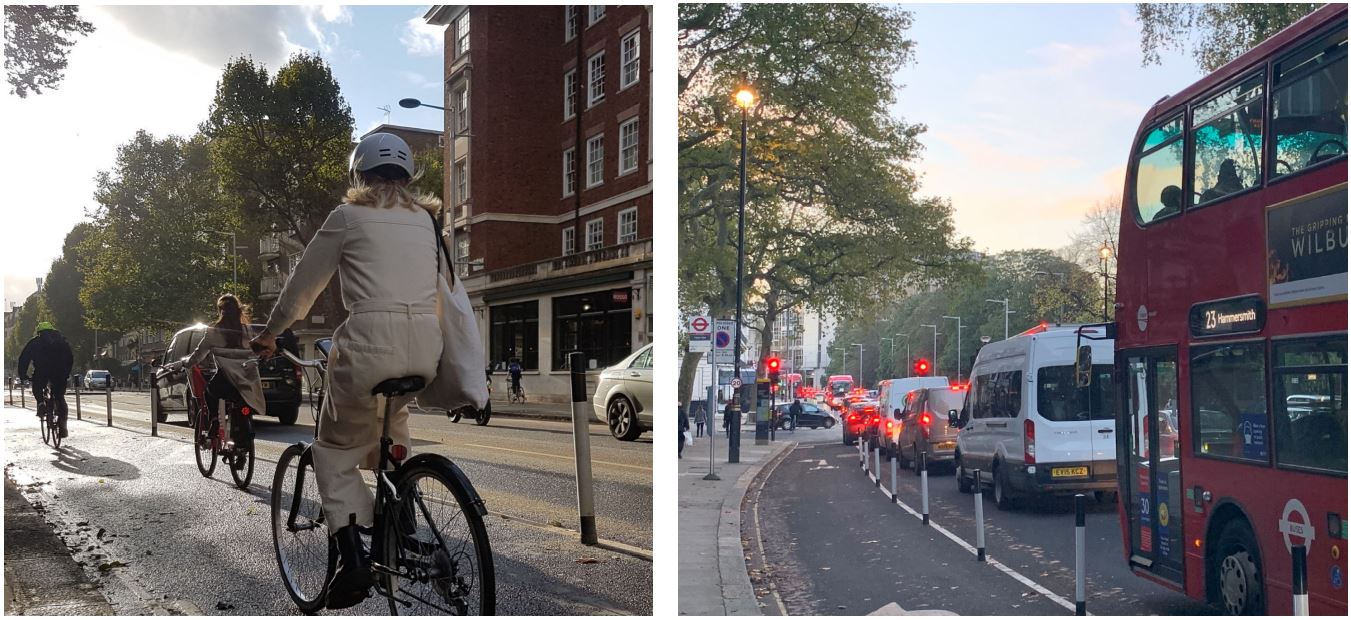Next week, Kensington and Chelsea council needs to decide what to do about the Kensington High Street cycle lane, and the initial council report has just been published.
The temporary cycle lane in Kensington High Street was opened last October, but was abandoned some seven weeks later and was fully removed within nine weeks of being implemented. To put it mildly, this proved to be a very controversial decision, and after some pressure, the council has agreed to look at the issue again.
The decision the council is to debate next Wednesday is whether to reintroduce the temporary cycle lane in Kensington High Street in full, in part, do nothing, or look for an alternative to be installed later.
One of the notable complaints raised by locals was that the cycle lane took up a lot of space considering how little it was used. However, traffic monitoring found that cyclists seem to use the lane in bursts — presumably held up further back by traffic lights, so it’s possible for there to be several minutes of no cyclists, followed by a large group of them.
The report accepts that could explain the disparity between overall volumes, and the apparent lack of use.
As cycling seemed to increase by around 50 per cent, and despite many people working from home, they saw a notable rush-hour peak, suggesting that there has been some switching from public transport to bicycles.
A counter-argument that the cycle lanes increase road traffic congestion seems inconclusive but is suggestive of a slight slowing down of road traffic speeds along the cycle lane route.
Removing the cycle lane did not seem to improve matters though, as the cycle lane effectively became a car park for stationary vehicles, so there wasn’t much of an increase in road space for motorists.
Whilst the evidence does not point to a firm conclusion, the council report says that all the options for the cycle lane debate are feasible and there is sufficient evidence rationally to justify them
The support and objects are mixed, some retailers liked them and others did not. Likewise for local organisations, although local residents associations were almost unanimously opposed. The emergency services were also unhappy, worried about the lack of overtaking space, and while the cycle lane wands are designed to be driven over if needed, the Fire Brigade at least tells its drivers not to do that.
There is also an issue of responsibility.
At the moment, Kensington High Street is managed by the council, although the Mayor of London does have the powers to take over the road if necessary — albeit then requiring TfL to pick up the cost of looking after it.
In terms of cost, while the headlines say that the cost of the cycle lane was around £320,000, in fact, that was for the entire project and only Phase 1 was delivered. That cost £171,500 (design: £85k, installation: £37.5k and the cycle lane wands: £49k).
Reinstating the lane would cost around the same as last time – circa £40,000.
The report is measured and it’s clear that the speed of installing the cycle lane — even if slower than elsewhere — has hampered their ability to say conclusively whether the cycle lane was a positive or negative for the local area due to the lack of time to carry out pre-installation surveys.
It’s also a debate that no matter what the decision is, the losing side is not going to go down quietly.
The council meeting is due to take place on Wednesday 17th March at 6:30pm and will be live-streamed here.








Residents associations are generally a couple of dozen very old CAVE’s who’d oppose the invention of the wheel if it happened before they they were old. Theres always 1000s who are quiet but are too busy with their own lives to spend it frothing at the mouth over something so benign as a short bike lane.
As a cyclist who lives in Holland ward and used the cycle lane I loved it. As a motorist who sometimes pops down to KHS I hated it. It removed all the single yellow line parking space and lorry delivery locations.
I believe a segregated cycle lane/ bus lane and vehicle parking can be accomodated with the width of the road, especially from Olympia through to the junction with Church Street.
Knowing how anti-cycle RBKC is, I have no doubts that they will not reinstate the lane. Honestly they are shockingly poor when it comes to do with cycling.
For years I supported my local west-London residents association but eventually came to understand it was a just a bunch of old, privileged, white folks who used it to maintain their Nimbyism.
While quick to protest against any new development, it totally ignored public transport unless there was going to be some impact on car parking. We finally parted ways when their megalomaniac leader became an anti-cycling crusader. Talk about out of touch
The issue with HiStKen is that there is literally no alternative on east/west routes between Notting Hill and Cromwell Road (neither attractive for quiet cycling). The Royal Parks have grudgingly provided some routes for cycling but Kensington (billionaires) Palace Gardens and the palace itself restrict all access along the west side of Ken Gardens. Below KHSt, the Circle line cut forms a barrier that has no public cross connection.
Cycle routes are links in a chain, and any missing link lowers its value. K&C could, of course, work to create alternative cycleways off KHSt. That is, if they didn’t hate cycling and cyclists
85 grand to “design” a cycle lane. Enough said
Based on your extensive experience, how much would you have charged and how are you able to do it for less?